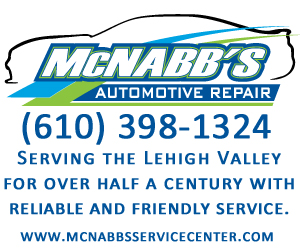PHOTO – Passing the Torch: The purging process is easier when you can pass on the memories. Celebrating our annual Fourth of July parade with our wonderful neighbors.
Written By: Carrie Oesmann, ASID, CAPS, AKBD | Bailiwick Interior Design LLC
It goes without saying that most people have too much stuff. For those of us who were blessed with a home that had a full basement and attic, well we just kept on accumulating that stuff, to a point where we did not even remember all the stuff that was packed away in all the little nooks and crannies. My husband, John, and I have recently moved to the Lehigh Valley from New Jersey. Of all the things that this transition entailed, by far the most difficult was the purging process! We had sold our home of 23 years and needed to close in 45 days. So what do you do? Well you just dive in!
Like most environmentally conscious people, I refused to accept the idea that I would have to throw away any of my used or unused belongings. Somehow, somewhere I was going to find people and places to take my hand-me-downs, so that I would not be accused of adding to our local landfills.
Admittedly, following this path will add at least 30% more time to your packing regimen. How did I come up with this number? Well, I figured it took me an additional 3 hours to bundle and pack up the donations each time I emerged from a cleansing session; often from 12am to 3am, so I am sure the late hour probably added another 30%! And this was not your healthy kind of cleansing, as I was really only surviving on Diet Coke and old Halloween candy during this time, (yes some of that “stuff” I had found included a big bag stashed in the foyer closet).
As someone who is a firm believer in using your personal experience to save others from pain and suffering, here are some tidbits I will share with anyone about to embark on a “purge”. (Now I highly recommend that this really means everyone! As I will never let my home or office get to that state again!)
1. If it looks like junk, it’s junk.
So in order to make my stuff seem less like “junk”, I sorted, wrapped, hung, and boxed everything in an organized fashion. I know this sounds a little OCD, but by really going through my “junk” with a different mindset it made a huge difference in the amount of things that became trash. A good example was all the board games. If a game was complete I put all the game pieces in a Ziplock bag and taped up the box with a note saying “Complete”. If things were missing, I pulled out the cardboard and papers, even the Monopoly money, and put it into the recycling. I even separated a bag of misc. game pieces and dice—who knows who could be looking for just that at the thrift store!
2. Handle with Care
Box up items properly; wrap glass items so they won’t get broken in the donation process. Then they really are junk. If items were really in good shape and more valuable, like a blue and white Chinese tea set we had gotten as a wedding gift (and never used), I brought them to donation centers myself and told the people in charge.
3. Where to donate?
Go online and do your research! Each charity has a website where they list what they will and won’t take. Big Brothers, Lupus, and Disabled Veterans of America all made multiple trips to our house. I am not talking one or two things with each pick up, I am talking donation bags that could no longer fit on my front porch, so we put them in the driveway… behind the PODS. One of the best charities I found was the local Visiting Nurses Association that had an annual rummage sale at the Far Hills, NJ, Fair Grounds (I made two trips!). If properly tagged, labeled and in working condition they will take most anything! Habitat for Humanity Re-Stores are a great place to take your better-condition items. Go onto their website, upload a picture and they will contact you if they can use it. They will even pick it up!
4. Household cleaners and assorted Hazardous chemicals…
It was amazing to me how many containers of cleaning products I had accumulated. Sadly, most of these were products I had tried that didn’t work and then I did not know how to dispose of properly. A good amount of it was products that former neighbors had given to us when they moved out of state or the country as these could not be stored in our PODs or transported. I felt it was my duty to stop the mad cycle and properly dispose of these items (I vow to never pass on old cleaning products to anyone)! After lots of research and multiple phone calls I found that our county had a disposal center nearby, you just had to make an appointment! It was a happy day when John pulled out of the driveway with a full load! I made him take responsibility when I discovered his boxes and boxes of automotive cleaning products in the garage far outweighed my household cleaners. After all, if I wanted my husband to appreciate my efforts and halt the flow of hazardous chemicals into our home, he needed to be part of the purging process!
5. Paint, paint, paint!
Ok, so you can imagine how much leftover latex paint I had. As an interior design professional I was constantly changing my own home interiors. I also knew that paint needs to be stored in a climate controlled environment, so my basement looked like a Benjamin Moore and Sherwin Williams dealership! I am not exaggerating when I say I had over 30 gallons of half-used paint—not something that is easy to donate and can’t be dumped in the trash as is. (Note: Habitat Restore is working on getting a paint recycling program up and running!) Here’s my trick: instead of purchasing costly paint hardener from Lowes or Home Depot, a better and less-costly way to go is simple kitty litter (the cheapest kind you can find works best)! You will build some arm muscle in the process, but the dried paint can be disposed of in the trash and the empty cans (sans lid in our former town) left at the curb.
6. Pass the Torch
There were other things that I had accumulated over the years that had to do with all the community service we had done. So when I went through all of my boxes in the basement and attic I found droves of resource materials and items that although I didn’t need in my next phase of life, certainly could be of value to someone. But again it took a little extra effort to find who that was. The 50-cup Kool-Aid dispenser and 75-cup coffee urn were passed along to our neighbor who took over the annual Fourth of July neighborhood parade we had hosted for the past 15 years. My boxes and files of Catholic Sunday School resource materials, along with the 12 youth bibles I had accumulated over the past 15 years of teaching CCD went to our parish catechism resource library. Purging is personal and it was important for me to feel that all that work was not in vane and those things that the items symbolized were important. But it also enabled me to move forward with a smile and a light heart!
7. Be Creative and Diligent!
Through myriad phone calls I even found a local Boy Scout troop to take my daughters 100+ sports trophies. Even though they had gold female figures in pony tails doing everything from soccer, baseball, basketball, volleyball and baton twirling on top, they refurbished them and used them for their scout awards programs. It can be done! And strangely enough it made it a little easier to let go of the memories, especially for my girls.
Yes, my home seemed like the proverbial telephone booth—the “stuff” just kept on coming out of the basement, attic, closets and garage, like a magician’s hat with a magic scarf. At times it did feel like a full-time job, but eventually the loads got smaller and the closets were emptied and I felt lighter. Yes, you will end up with trash at the end of the day, but you will rest easy knowing that you did your part and with fewer regrets. In fact, looking back, my only regret is that I didn’t start the purging process 10 years earlier!
Moral of my story: If you think you may ever move again, start purging NOW.
About the Carrie,
Carrie Oesmann is the ASID, CAPS and AKBD certified Interior Designer of Bailiwick Interior Design, a business she has owned and operated in New Jersey since 1999. Last year she had the pleasure of expanding her business and relocating to the Lehigh Valley, so she now lives in downtown historic Bethlehem with her husband John, a great guy who at times suffers from “capability-immobility” himself. Carrie reminds John and all her clients that life is short and there should be time for other things besides home improvements—which is what lead them to the Lehigh Valley! The couple agreed that Bethlehem provided that perfect microcosm feel of NYC, without the hustle of the big city. Carrie’s home also doubles as Bailiwick Interior Design’s Pennsylvania office and unique lifestyle showroom, a place where her clients can experience a variety of options in a real home—it’s unlike anything we have seen in the Valley! Call Carrie for a personal tour of the lifestyle showroom.
Website: bailiwickdesign.com







